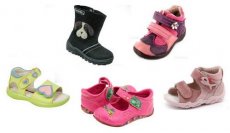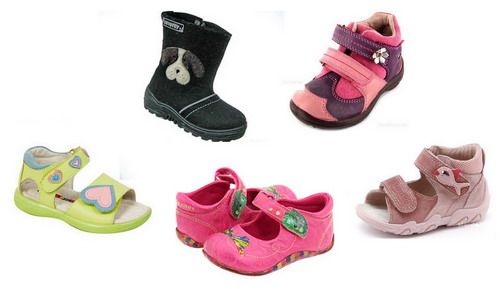Medical expert of the article
New publications
How to choose the right orthopedic shoes for a child?
Last reviewed: 08.07.2025

All iLive content is medically reviewed or fact checked to ensure as much factual accuracy as possible.
We have strict sourcing guidelines and only link to reputable media sites, academic research institutions and, whenever possible, medically peer reviewed studies. Note that the numbers in parentheses ([1], [2], etc.) are clickable links to these studies.
If you feel that any of our content is inaccurate, out-of-date, or otherwise questionable, please select it and press Ctrl + Enter.

When choosing orthopedic shoes for children, you should not delay and wait until they grow up. Because statistics show that more than 90% of small patients with foot deformities were not born with these deviations, but acquired them as a result of improper wearing of shoes. How to choose orthopedic shoes for children?

 [ 1 ]
[ 1 ]
Let's fight flat feet
This needs to be done immediately. Very often, parents try to buy their son or daughter shoes that are more expensive and more beautiful, without caring at all about their orthopedic properties. And then the shoe last is uncomfortable, the toes are pinched, the heel is unstable, and the heel lets you down. As a result, the child's feet get tired much faster than they should, flat feet develop, and the incorrect position of the feet provokes serious diseases. According to statistics, more than a third of children under 18 have foot deformities and need orthopedic shoes. Flat feet are the most common disease in children under 18.
True, there are different types of flat feet. Foot deformation is divided into at least two varieties. The first is a hollow foot, the second is a deformation of the transverse or longitudinal arches of the foot. Bunions or bones on the feet (on the big toe) are also a type of flat feet. The child's foot becomes flat, the center of gravity shifts, and the legs no longer perform their functions so well. Because of this, a number of diseases of the musculoskeletal system, heart disease, blood vessels, and nerves arise.
If flat feet are not treated in time, these diseases will also worsen. One of the good ways to prevent flat feet in a child or treat an existing disease of the arch of the foot is orthopedic shoes.
How to choose orthopedic shoes correctly?
You cannot know for sure whether you have chosen the right orthopedic shoes for your child in the store. Even if the child is not completely comfortable in these shoes, he may not understand this and not tell you. This threatens further uncomfortable positioning of the foot, displacement of the support point, balance and inconvenience when walking and running.
This irritates the child, he becomes nervous, capricious, gets tired quickly, sleeps poorly. To avoid this, let's choose orthopedic shoes correctly. You need to start with the baby's room, and not with the counter of a shoe store, as many parents think. Take a sheet of thick paper, the kind on which it is easy to draw with a pencil or pen. Let the child put his feet on it, and you trace the feet. This outlined silhouette should be carefully cut out with scissors.
When trying on orthopedic shoes for your child, play it safe with these improvised insoles. Place them on the sole of the model you have chosen. If the sole outline is longer, wider or much narrower than the sole, it means that the child will not be comfortable in the orthopedic shoes you have chosen. They may be too tight or, on the contrary, too loose on the foot. The template may either match the sole or be slightly narrower than it. Once you have chosen orthopedic shoes of a normal size using the template, you can try on the shoes, shoes or sandals that your child likes.
How to try on children's orthopedic shoes correctly?
When trying on children's orthopedic shoes, you must not let them press on the toes or heels - in general, you must not let the shoes pinch. If the child is comfortable in the shoes, that's good. But you shouldn't overdo it and buy orthopedic shoes that are too big. If you buy shoes that are too loose, fearing the other extreme - tightness and chafed heels, then other problems may arise with the child's feet.
The foot will constantly strain, trying to take a comfortable position, but it will not be possible to take such a position, because the foot does not have a comfortable reliable support. As a result, the child will feel uncomfortable moving, so parents should not be surprised that he may develop diseases of the musculoskeletal system. Therefore, you cannot buy orthopedic shoes for growth, it is better to choose them according to size.
And at the same time, parents should remember that a child's shoes, even the best ones, should be well-groomed. In winter and autumn, a child's feet can often get wet or sweaty, orthopedic shoes also become damp, and it is not always possible to dry them. Therefore, you need to buy at least 2 pairs of orthopedic shoes for each season for your child to be able to change their shoes. In addition, changing children's shoes allows you to maintain their appearance longer. Shoes will look "like new" for a long time. There is one feature of orthopedic shoes: if they are heavily worn, they automatically lose their properties, even if they fit the child's foot.
Shoes should not only fit your feet, they should also serve their intended purpose. For example, you shouldn't wear heavy sneakers in the gym that are comfortable for running around a football field, and in the cold season, you shouldn't let your child out on the basketball court in tennis shoes.
How to choose orthopedic shoes for a child according to age?
One of the main roles of orthopedic shoes for children is the prevention of diseases associated with incorrect foot position, and especially flat feet. This important task should be addressed from the moment the child begins to walk.
From the moment the child starts walking on his own and up to 4 years of age, orthopedic shoes that cover the ankle area well are needed. If you do not follow this recommendation of orthopedists, too short orthopedic shoes will not be able to provide the necessary protection for the child's foot, the feet will get tired very quickly, the toes may lose their shape and become crooked.
The toes of such shoes should be wide enough so that the toes are not squeezed. It is also advisable to choose closed toes, because they will be able to protect the child's delicate, fragile toes from damage. The sole of orthopedic shoes for a child should not be made of rubber. It should be light, flexible, but strong, and prevent slipping.
As soon as the child is 6 years old, you can already buy orthopedic shoes with heels. They should be small, but stable, with a good area on which it is easy to lean. Focus on the fact that the height of the heel for a child from 6 years old should be one fourteenth of his foot. When a baby wears such orthopedic shoes, his (her) back and leg muscles and bones are trained, and posture is greatly improved.
Such orthopedic shoes must have an insole, well glued, and also arch supports. This will allow the child's foot to spring well and prevent flat feet.
Material of orthopedic shoes for children
In order for the child's foot to feel comfortable, forget about the fact that you were going to save on the child's shoes. They should be made only of natural materials - leather, fabric, nubuck. They breathe and allow the child's foot to breathe, fix the foot as it is necessary. In shoes made of leatherette, on the contrary, the child's foot does not breathe, and harmful fumes, remaining inside, are saturated with toxins and bacteria, which very quickly multiply in such an environment.
Foot deformities develop most rapidly at the most tender age – from 8 months to one and a half years. It is at this age that you need to be especially careful about choosing the right orthopedic shoes for your child. If you choose it incorrectly, not only the foot can be deformed, but also the posture, and the entire musculoskeletal system of the baby can undergo major changes. And they will not always be beneficial.
If the foot has started to deform anyway – you didn’t notice – you need to order medical insoles, also known as supinators. They have a special surface with a porous relief that absorbs excess moisture and prevents the child’s foot from getting damp. Insoles with the supinator function will help the child’s foot to stay in an anatomically correct position for a long time. This will relieve the load from most muscles and ligaments, and will also give a load to those muscles and ligaments that were not previously used or were weakly used.
If such orthopedic insoles are worn constantly, the foot, which had already begun to curve or which has developed flat feet, returns to the correct position. To choose orthopedic insoles correctly, you need to consult an orthopedic doctor. And then monitor the situation every 3 months. To cure a child's foot, which has already begun to form incorrectly, orthopedic shoes must be worn for at least six months.
The maximum period for eliminating severe deformation of a child's leg is the right choice

